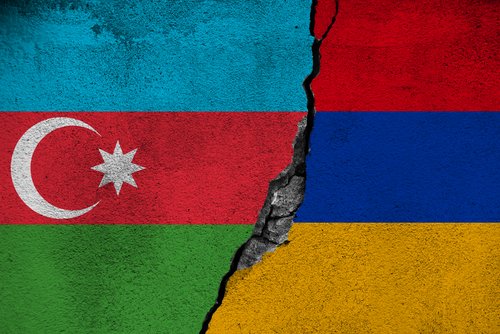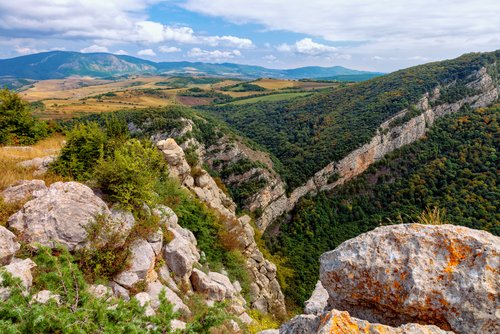ECMI Minorities Blog. Armenia-Azerbaijan at War and New Uncertainties for the Minorities of Nagorno-Karabakh


Authors: Marika Djolai and Viktoria Aygül
An estimated one million people were displaced and 30,000 killed by the six-year Nagorno-Karabakh (Karabakh) war, between Azerbaijan and neighbouring Armenia, which started in 1988 while both were still Soviet republics. At the time of the ceasefire in 1994, which officially ended the war, some had hoped that the violence will abate and not reoccur in the years to come. However, the hopes proved false. Fresh violence broke out in the Karabakh region in 2016, and again at the end of September this year with more drastic consequences. In the violence that lasted for six weeks, Azerbaijani military forces managed to (re)capture some of the territories which were under Armenian control for nearly three decades.
The breakaway Nagorno-Karabakh Republic (NKR), or by its other official name Republic of Artsakh (since 2017) is internationally recognised as territory of Azerbaijan. In the last century, the territory existed as the Nagorno-Karabakh Autonomous Oblast, a territorial part of the Soviet Socialist Republic (SSR) of Azerbaijan since 1923 under the Soviet Union until its dissolution. Always volatile, situated in Asia on the very border with Europe, Karabakh has been trapped in deeply entrenched challenges connected to land and its people, history and how it shaped their collective identities. It is often considered among de-facto states, while its problems can be situated in two core principles of the Helsinki Final Act: the right to self-determination by the residents and the right to territorial integrity.
Firstly, the right to territorial integrity is reflected in article IV. Territorial integrity of States of the Helsinki Final Act, which affirms that the participating states shall respect the territorial integrity of each other and refrain from any action or measures violating this principle, while any occupation or acquisition is considered to be illegal. This principle of territorial integrity is supported by the UN Security Council Resolutions (1993) on Nagorno Karabakh, which the President of Azerbaijan, Ilham Aliyev, also refers to in his latest interviews to the CNN, Euronews and Russian news Agency TASS. The Resolutions for the territories of Kelbadjar disctrict, the district of Agdam, the Zangelan district and the city of Goradiz are occupied by the local Armenian forces call for a peace process, while emphasising the territorial integrity of Azerbaijan Republic.
Secondly, Armenia in its actions relies on the right of self-determination secured by article VIII. Equal rights and self-determination of peoples of the Helsinki Final Act. The principle explains that “all peoples always have the right, in full freedom, to determine, when and as they wish, their internal and external political status, without external interference, and to pursue as they wish their political, economic, social and cultural development”. The Armenian population which constitutes the majority in Nagorno Karabakh believes in the right of self-determination. As a showcase, public demonstrations in favour of independency of Nagorno-Karabakh accompanied the latest presidential campaign in February 2020. The candidates were emphasising self-determination by democratic means as the driving force to reach peace, security and stability in the region.
Historically, the territories in the region of South Caucasus have never changed hands without violence, alternation of the demography and forced denial of culture and identities of its residents. Even its name comes with peculiarities, as Laurence Broers points out. His preferred address for the region is Nagorny Karabakh (Russian), because it helps with avoiding “embroilment in the naming and numbering of the belligerents, and because it underscored that the conflict is, in essence, territorial”. Or simply Karabakh that we also use in this piece. His book “Armenia and Azerbaijan” (2019) examines the complex relationship between the two countries, including brief, violent hostility from 2016, which dates further in the past. Armenians justify their claims over Karabakh territory by stating fear of repetition of annihilation and genocide (1915) of its people based on their identity.
Observed from the formal status and international law, Armenians residing on NKR territory are in fact one of the 16 minority groups (“nationalities”) living in Azerbaijan, alongside Lezgins (2%), Russians (1.5%), Taylish (1.3%) and others. The Advisory Committee on the Framework Convention for the Protection of National Minorities in their 2017 Azerbaijan Report noted significant discrepancies between the census data and information collected from interlocutors and the local population during the visit. For example, according to informal sources there are as many as 30,000 Armenians living in Baku, while only 104 persons self-identified as belonging to this minority group in the 2009 census. Armenia, according to the 2011 census is mostly populated by Armenians, with small minorities of Yezidis (1.3%), Russians and others.
In the latest census of 2015, there are 150,932 people living in Nagorno-Karabakh. Among them Armenians constitute the overwhelming majority, living alongside small numbers of Russian, Ukrainian, Yezidi (Kurdish), Georgian and Syrian minorities. The Azeri population was displaced with the outbreak of the conflict in 1990s from their homeland, with an estimated 600,000 living in Azerbaijan as internally displaced persons (IDPs). The numbers shaped by the history of massacres on both sides show that the historically embedded quest for mono-ethnic Nagorno- Karabakh and the surrounding countries has achieved its unfortunate goal in the 21st century, making inter-ethnic coexistence almost impossible.
Inside Karabakh, the facts point to a captured state, irrespective of its informal status. According to the 2019 Freedom House Report, there are multiple violations of human and minority rights in the region. For example, the freedom to express and practice faith is limited to Armenian Apostolic Church (or the “national church” of the Armenian people). The Law on Freedom of Conscience and Religious Organizations (2009) prohibited any activities of unregistered religious organizations and at the same time made the registration procedure for minorities more complicated. The academic and educational freedoms are also under political pressure and thus, limited to the “official” (Armenian) point of view. The political pressure also finds its reflection in the local media, which is self-censored and doesn’t touch upon topics related to the peace processes. These pre-conditions, in combination with the latest developments, make the permanent peace solution even less perceptible to the people in Karabakh.
Politicisation of the Ombudsman institution is another serious complication. The reports of NKR Ombudsperson Artak Beglaryan detail the cases of Azeri aggression and actual casualties but not the cases of corruption, mismanagement and political protectionism or other minority rights violations. Information in English presented on the official website of the Ombudsperson is also scarce and can be seen as contributing to the mutual blame game conducted by both sides of the conflict. Thus, the latest general report of 26th October 2020 available in English mentions “ethnic cleansing and terror-inspiring means against the Armenian civilian population”. The general report of 2016 makes claims of “Armenophobia” in Azerbaijan, organized Hate Speech and animosity towards Armenians, while the report of April 2016 considers the alleged atrocities committed by Azerbaijan during the 2016 April War. In the current state of escalation, it is also difficult to judge whether the human and minority rights on the Karabakh territory are respected and implemented, and whether the complaint mechanism to Ombudsperson actually works.
In the climate of domineering political games and the lost war, what is the situation of the Nagorno-Karabakh residents? The President of Azerbaijan Ilham Aliyev assures that, in case of withdrawal of the Armenian forces, the local Armenian population will be allowed to remain residents in Nagorno- Karabakh. However, judging on past experiences, this commitment is unlikely to be upheld. Armenians living on the territories handed over to Azerbaijan will need to seek the country’s citizenship and passports if they wish to remain living in their houses or, what most other residents have done over the past decades, to move by force or by will. Furthermore, Armenia has been accused of the destruction and seizure of Azerbaijani national and cultural heritage since capturing the territory in 1990s. The next step is broadly feared retaliation and what Thomas de Waal calls war over cultural heritage given that number of Armenian monuments will be handed over to Azerbaijan in the re-captured territories. In other words, it is difficult to see the end of hostilities and stability for those who are minorities, in what can be defined as continuation of conflict, without violence.
Many analysts point out that it shouldn’t be labelled a frozen conflict. De Waal calls it a “smouldering conflict” which could reignite. Broers proposes to substitute conflict with rivalry as the framework of analysis, to avoid “the dichotomies of ‘war/peace’ and ‘hot/cold conflict’ and to shift the analysis to a process-driven focus on the sustainability of rivalry.” However, the ‘conflict’ reference better encompasses not just reoccurrence of open, military, violence but a refusal to defuse tensions inside Karabakh by changing local political discourse and genuinely moving away from keeping the rivalry at the forefront of daily life.
Where Madrid Principles (2007) failed, latest peace agreement seemingly succeeded leading to ceasefire on 10th November. However, it was brokered by Russia, and not only exposed the the EU’s weakness in the region, but permitted the stationing of its peacekeeping troops, which was Russia’s long- term political game. The other player in the game, Turkey, an ally of Azerbaijan, is satisfied with the outcome too as the territorial ‘victory’ demonstrated its growing influence in the region. Both of these superpowers are embroiled in a different type of conflict, and the tiny region of Nagorno-Karabakh’s stability is ultimately side lined in this big game.
The future of Armenians and Azeri people of Nagorno-Karabakh is uncertain with regards to their rights and who will guarantee them. In shifting from majority to minority population or IDP status, their identities and aspirations also remain contested, while the context makes it impossible to showcase examples of the relationships in everyday life that manage to bypass these challenges. The local peace is still struggling to find its voice.

Commentaries
If you wish to write a commentary on this blog post, please contact the ECMI Minorities Blog editor Dr. Marika Djolai.

